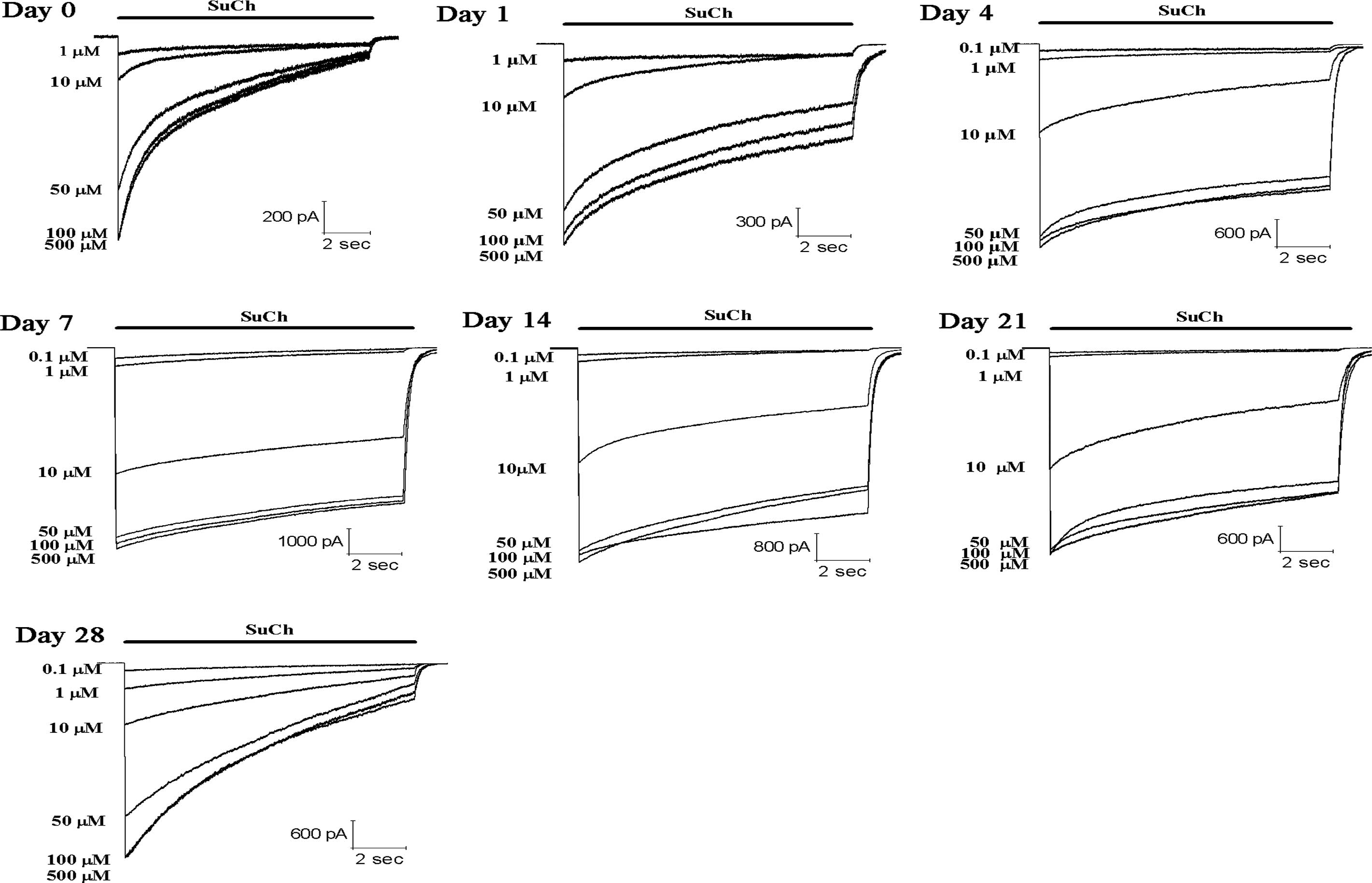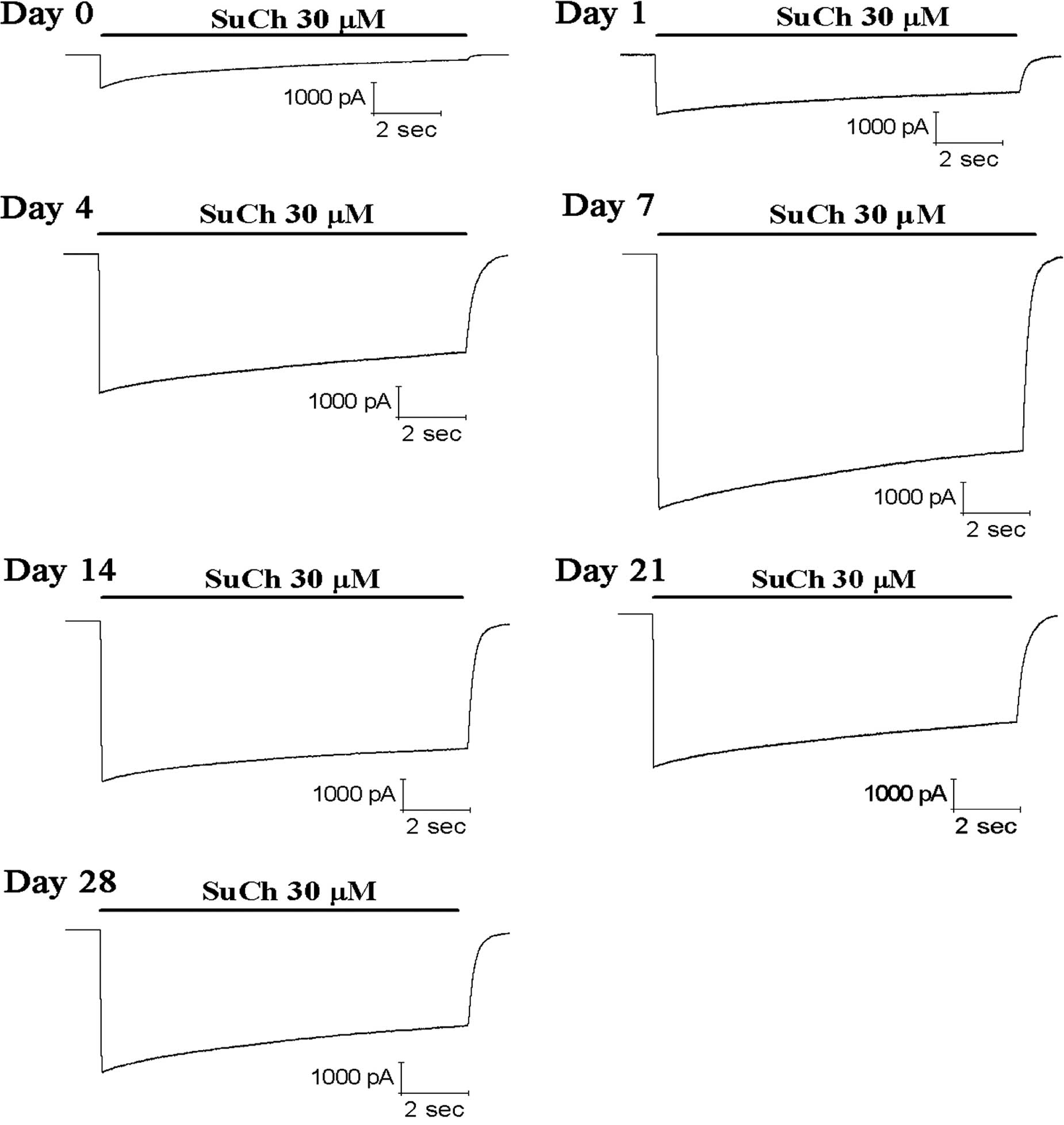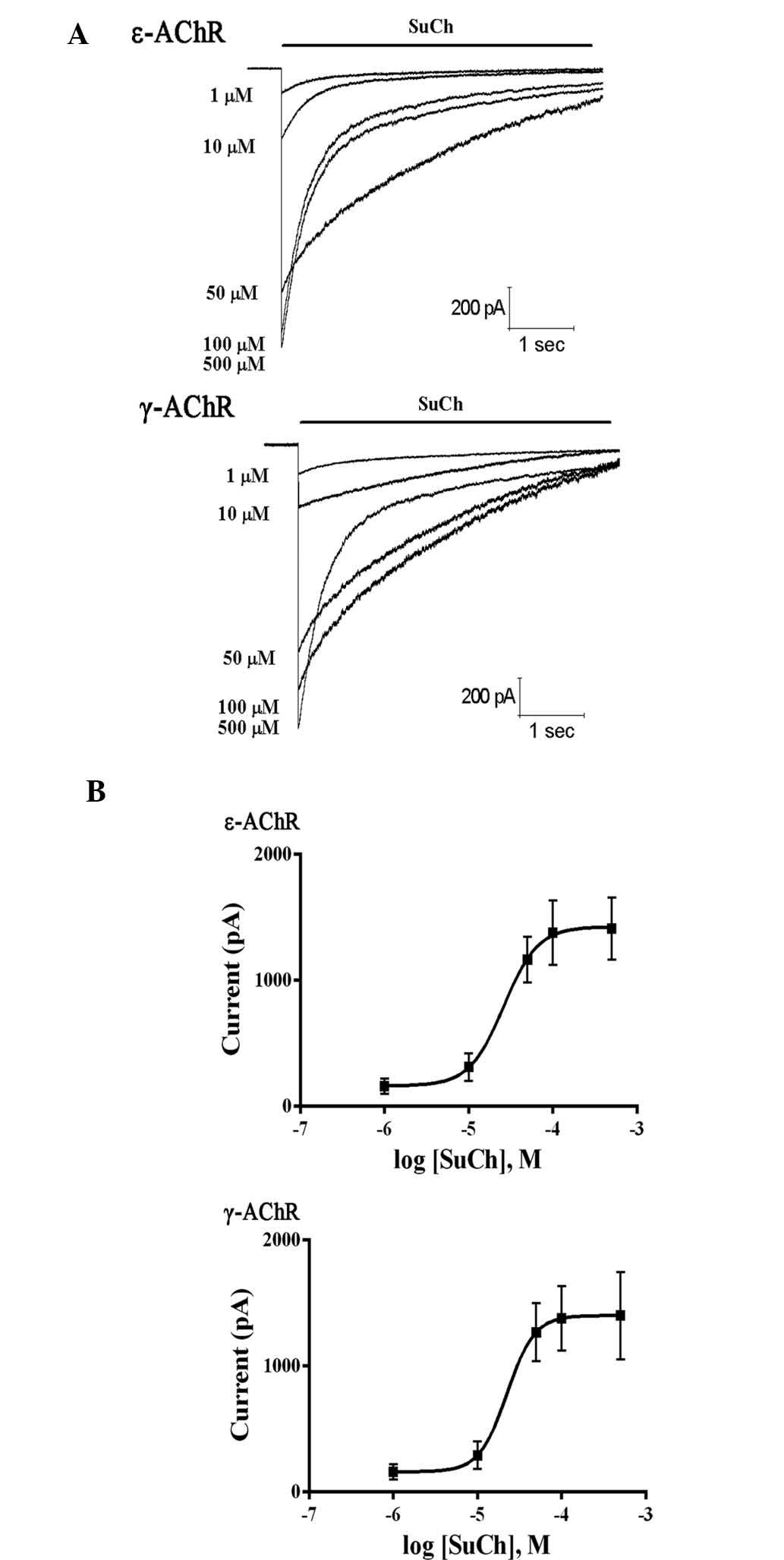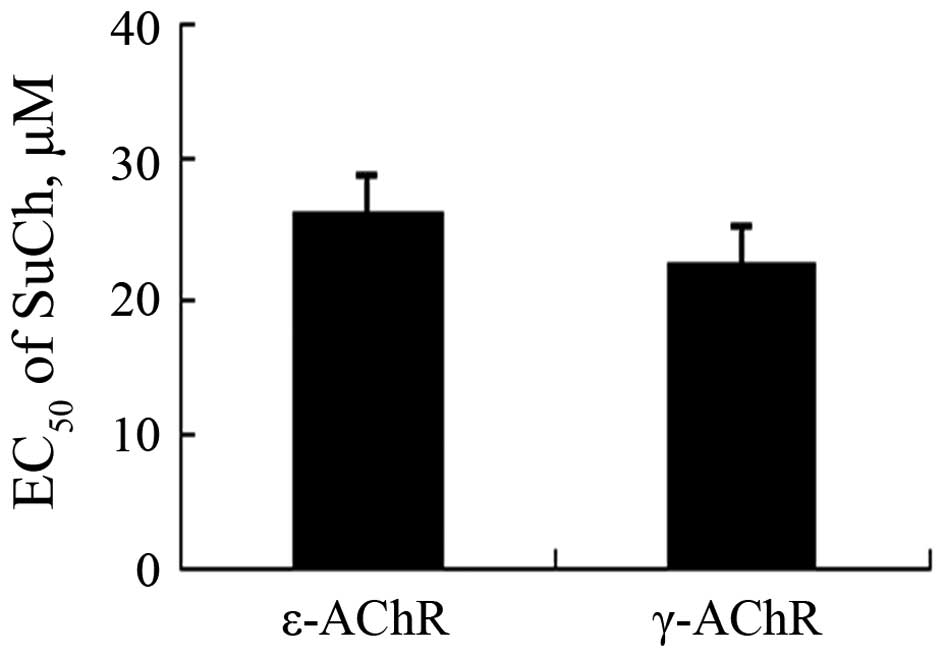Effects of skeletal muscle denervation on the potency of succinylcholine
- Authors:
- Published online on: September 30, 2015 https://doi.org/10.3892/mmr.2015.4392
- Pages: 7796-7800
Abstract
Introduction
Succinylcholine (SuCh) is currently used in the clinic to achieve muscle relaxation, particularly when there is a demand for rapid onset and elimination of contraction. Due to its rapid onset, short half-life and reliably, SuCh treatment creates excellent intubation conditions. At present, no non-depolarizing relaxants that possess suitable pharmacodynamic characteristics for replacing SuCh are available (1,2). Therefore, SuCh is most frequently applied prior to urgent tracheal intubation in the peri-operative period, at intensive care units and emergency departments, and even outside the hospital during emergency transportation of patients (3–6).
However, thermal injury and other forms of critical tissue damage can cause denervation-associated changes in skeletal muscles (7). Denervated skeletal muscle displays two characteristic changes: An increase in the number of nicotinic acetylcholine receptors (nAChRs) and de novo expression of fetal-type nAChR (γ-AChR) (8). Upregulation of nAChRs results in increased sensitivity to SuCh and resistance to non-depolarizing relaxants (7–11). Certain studies reported that after denervation, levels of nAChR and γ-AChR changed with time; furthermore, the IC50 of d-tubocurarine (dTC) correlated positively with nAChR and γ-AChR mRNA levels at different time-points after denervation (12–14). All of theses results indicated that the potency of muscle relaxants may change with increasing time of skeletal muscle denervation.
The aim of the present study was to assess the changes in the potency of SuCh during the first month after denervation in a mouse model. Furthermore, the present study investigated whether the de novo expression of γ-AChR contributed to the increased sensitivity of denervated skeletal muscles to SuCh.
Materials and methods
Denervation
The present study was approved by the Animal Care and Use Committee of Bengbu Medical School. Balb/C mice (35 days old) were anesthetized with pentobarbital, (40 mg/kg intraperitoneally). A sample of a few millimeters in size of the right sciatic nerve was excised through a small (3–5 mm) incision above the hip. The incision was sutured with a single stitch. Animals were sacrificed at 1, 4, 7, 14, 21 and 28 days after denervation by pentobarbital anesthesia and cervical dislocation. Animals that had received surgery without incision of the sciatic nerve were used as the innervated control (0 days after denervation).
Isolation of muscle fibres
Single skeletal muscle cells from the flexor digitorum brevis (FDB) muscle were obtained from the hindfeet of the mice. The muscles were incubated for 3 h with Dulbecco's modified Eagle's medium (DMEM; Invitrogen Life Technologies, Carlsbad, CA, USA) containing 10% fetal calf serum (FCS; Invitrogen Life Technologies), 100 U/ml penicillin (Sigma-Aldrich, St. Louis, MO, USA), 100 µg/ml streptomycin (Sigma-Aldrich) and 0.2% collagenase 1A (Sigma-Aldrich) with agitation at 37°C. Subsequently, flexor digitorum brevis (FDB) muscles were disaggregated into single muscle cells by repetitive pipetting using Pasteur pipettes of various tip sizes.
Expression of nAChR in human embryonic kidney (HEK)293 cells
Expression plasmids Psp65α, Psp65β, Psp65δ, Psp64γ, and Pbssk(+)ε, encoding complementary DNA-coding sequences for the mouse muscle nAChR sub-units α, β, δ, γ and ε, respectively, were provided by the Salk Institute for Biological Studies (La Jolla CA, USA). These plasmids were sub-cloned into pcDNA3.1+ (Invitrogen Life Technologies). HEK293 cells (Shanghai Institute of Biochemistry and Cell Biology for Biological Sciences, Shanghai, China) were cultured in DMEM supplemented with 10% FCS, 100 U/ml penicillin and 100 µg/ml streptomycin at 37°C in an incubator containing 5% CO2. The HEK293 cells were stably transfected with Lipofectamine™ 2000 (Invitrogen Life Technologies) according to the manufacturer's instructions. After transfection, positive cell clones were selected with G418 (Invitrogen Life Technologies). The transfected cells were then incubated for 24 h prior to being subjected to the electrophysiological assays.
Electrophysiology
FDB muscle cells or HEK293 cells were voltage-clamped using a whole-cell patch clamp technique (15). All experiments were performed at room temperature (20–24°C). Patch pipettes were pulled from borosilicate glass using a Flaming Brown micropipette puller (P97; Sutter Instrument Co., Novato, CA, USA), ranging from 1–2 MΩ. The pipette electrode was filled with the following solution: 140 mM KCl, 10 mM 4-(2-hydroxyethyl)-1-piper-azineethanesulfonic acid (HEPES), 10 mM ethylene glycol tetraacetic acid, 1 mM CaCl2 and 1 mM MgCl2; the pH was adjusted to 7.2 with KOH. The external solution contained 5 mM KCl, 140 mM NaCl, 1 mM CaCl2, 1.25 mM MgCl2, 10 mM HEPES, 10 mM glucose and 0.5 µM atropine sulfate, and the pH was adjusted to 7.4 with NaOH. The cells were voltage-clamped at -80 mV in a whole-cell configuration after obtaining GΩ seals. A major amount of the series resistance (60–80%) was compensated. Currents were recorded with an EPC10 amplifier (HEKA Elektronik, Lambrecht, Germany) and PatchMaster software (v2.15; HEKA Eletronik), sampled at 10 kHz.
SuCh (Sigma-Aldrich) was dissolved in the external solution and applied via a gravity-driven perfusion system. Solutions and subsequent dilutions were prepared immediately prior to the experiments.
Test solution applications containing various concentrations of SuCh (1–500 µM) were applied for 10 sec to the skeletal muscle cells obtained from mice sacrificed on days 0, 1, 4, 7, 14, 21 and 28 after denervation or to HEK293 cells for 5 sec, and the peak current was determined. The washout time between each drug application was at least 60 sec in order to minimize the amount of desensitization throughout the course of an experiment. Currents were acquired from five skeletal muscle cells taken from at least two mice or five HEK293 cells.
Statistical analysis
Data analysis was performed off-line using Origin 8 (OriginLab, Northampton, MA, USA) and GraphPad Prism 4 (Graphpad Software, Inc., La Jolla, CA, USA). Concentration-response curves were fitted to the four-parameter logistic equation by non-linear regression analysis, and the EC50 was calculated as the concentration of the agonist eliciting a half-maximal response. Values are expressed as the mean ± standard deviation. Statistical significance was assessed by one-way analysis of variance followed by Tukey's test or unpaired two-tailed Student's t-tests. P<0.05 was considered to indicate a statistically significant difference between values.
Results
SuCh at various concentration (1–500 µM) was applied for 10 sec to mouse skeletal muscle cells on days 0, 1, 4, 7, 14, 21, and 28 after denervation. SuCh elicited concentration-dependent inward currents (Figs. 1 and 2). The data were fitted to a logistic equation. The SuCh concentration producing 50% of the maximal response (EC50) was 27.5 µM for the nAChR in the innervated skeletal muscle (day 0 after denervation). Compared with the EC50 value at day 0 after denervation, the EC50 values were decreased by 20 (P>0.05), 56, 73, 66, 60 and 62% (P<0.05) on days 1, 4, 7, 14, 21 and 28 after denervation, respectively (Fig. 3).
Application of 30 µM SuCh produced inward currents with different amplitudes at the nAChRs of skeletal muscle cells on days 0, 1, 4, 7, 14, 21 and 28 after denervation (Fig. 4). Compared with the current responses on day 0 after dener-vation, the current responses induced by 30 µM SuCh were increased by 1.9-, 4.6-, 9.4-, 7.1-, 5.2- and 5.1-fold (P<0.05) at days 1, 4, 7, 14, 21 and 28 after denervation, respectively (Fig. 5).
To further determine the effects of SuCh on nAChR sub-types, HEK293 cells were stably transfected with plasmids expressing either ε- or γ-AChR and then treated with SuCh. SuCh elicited currents in the HEK293 cells in a concentration-dependent manner (Fig. 6). However, comparison of the EC50 values revealed that no significant differences were present between the effects of SuCh on currents in ε-AChR- and γ-AChR-expressing HEK293 cells (P>0.05) (Fig. 7).
Discussion
The present study determined the effects of short-term denervation on the sensitivity of skeletal muscles to SuCh. As previous studies have indicated the amount of membrane nAChR after denervation changed with time (7,8), the present study further assessed whether the increased sensitivity to SuCh after denervation was associated with the presence of γ-AChR.
The present study generated a murine denervation model according to methods of previous studies by our group (7,8,11). Innervated and denervated skeletal muscle cells were obtained at various time-points after denervation. Compared with the values obtained from innervated skeletal muscle cells, the potency of SuCh significantly increased at day 4, peaked at day 7 and declined by day 14. Ibebunjo and Martyn (12,16) demonstrated that burn injuries induced increases in nAChRs at days 4, 7 and 14 in rat skeletal muscles. Furthermore, Adams et al (14) reported that denervation increased the expression of all sub-unit genes of nAChRs during the first month of denervation. Furthermore, previous studies by our group have confirmed that short-term muscle denervation leads to a changing pattern of resistance to non-depolarizing muscle relaxants that can be attributed to upregulation of mature and immature nAChRs on the muscular membrane (8,11).
The present study assessed the activated current amplitude following application of 30 µM SuCh on nAChRs in innervated and denervated skeletal muscle. Compared with that in innervated skeletal muscle cells, the current amplitude after denervation was significantly increased. The time-course of increases in the current amplitude after denervation was similar to that of the EC50 of SuCh. Consistent with the results of the present study, a previous study on the denervation of a single limb, a hyperkalemic response to SuCh occurred as early as on day four after denervation (17). Therefore, Gronert (18) suggested that it is advisable to avoid the use of SuCh beyond 48–72 h of denervation.
nAChRs include two sub-types: The adult form (ε-AChR) composed of α2βδε sub-units and the fetal form (γ-AChR) containing α2βδγ sub-units (7). Only ε-AChR is expressed in adult muscle; however, denervation results in the de novo expression of γ-AChR (19). Ibebunjo (12) reported that resistance to dTC is associated with the expression of γ-AChR. In addition, a previous study by our group demonstrated that the phenomenon of different magnitudes of resistance to non-depolarizing muscle relaxants in denervated mouse skeletal muscles is due to the different potencies of individual non-depolarizing muscle relaxants with regard to nAChR sub-units (7). The present study examined the effects of SuCh on currents in HEK293 cells heterologously expressing ε-AChR or γ-AChR. The results showed that SuCh had equipotent effects on cells expressing either of the receptor sub-types. Similarly, Yost and Winegar (20) reported that there were no significant differences in the EC50 for SuCh on ε-AChR and γ-AChR, and that ε-AChR had a six- to eight-fold higher intrinsic activity for SuCh than γ-AChR. The results of the present study therefore indicated that the changes in sensitivity of muscle cells to SuCh after denervation are not associated with the de novo expression of γ-AChR.
In conclusion, the present study found that short-time denervation resulted an increased sensitivity of muscle cells to SuCh, which is unlikely to be associated with the de novo expression of γ-AChR. After denervation, the potency of SuCh significantly increased by day 4, peaked at day 7, declined by day 14 and remained constant until day 28. These results suggested that it is advisable to avoid the use of SuCh at day 4 after denervation and thereafter in order to prevent lethal hyperkalemic responses.
Acknowledgments
The present study was supported by the National Natural Science Foundation of China (no. 30571796).
References
|
Miller R: Will succinylcholine ever disappear? Anesth Analg. 98:1674–1675. 2004. View Article : Google Scholar : PubMed/NCBI | |
|
Caldwell JE: The continuing search for a succinylcholine replacement. Anesthesiology. 100:763–764. 2004. View Article : Google Scholar : PubMed/NCBI | |
|
Laurin EG, Sakles JC, Panacek EA, Rantapaa AA and Redd J: A comparison of succinylcholine and rocuronium for rapid-sequence intubation of emergency department patients. Acad Emerg Med. 7:1362–1369. 2000. View Article : Google Scholar : PubMed/NCBI | |
|
Marsch SC, Steiner L, Bucher E, Pargger H, Schumann M, Aebi T, Hunziker PR and Siegemund M: Succinylcholine versus rocuronium for rapid sequence intubation in intensive care: A prospective, randomized controlled trial. Crit Care. 15:R1992011. View Article : Google Scholar : PubMed/NCBI | |
|
Norwood S, Myers MB and Butler TJ: The safety of emergency neuromuscular blockade and orotracheal intubation in the acutely injured trauma patient. J Am Coll Surg. 179:646–652. 1994.PubMed/NCBI | |
|
Ma OJ, Atchley RB, Hatley T, Green M, Young J and Brady W: Intubation success rates improve for an air medical program after implementing the use of neuromuscular blocking agents. Am J Emerg Med. 16:125–127. 1998. View Article : Google Scholar : PubMed/NCBI | |
|
Wang H, Yang B, Xu YF, Yan T and Li ST: Different magnitude of resistance to nondepolarizing muscle relaxants in the denervated mouse skeletal mucle. Acta Pharmacol Sin. 31:399–404. 2010. View Article : Google Scholar : PubMed/NCBI | |
|
Wang H, Yang B, Han GW and Li ST: Potency of nondepolarizing muscle relaxants at muscle-type acetylcholine receptors in denervated mouse skeletal muscle. Acta Pharmacol Sin. 31:1541–1546. 2010. View Article : Google Scholar : PubMed/NCBI | |
|
Martyn JA, White DA, Gronert GA, Jaffe RS and Ward JM: Up-and-down regulation of skeletal muscle acetylcholine receptors. Effects on neuromuscular blockers. Anesthesiology. 76:822–843. 1992. View Article : Google Scholar : PubMed/NCBI | |
|
Yanez P and Martyn JA: Prolonged d-tubocurarine infusion and/or immobilization cause upregulation of acetylcholine receptors and hyperkalemia to succinylcholine in rats. Anesthesiology. 84:384–391. 1996. View Article : Google Scholar : PubMed/NCBI | |
|
Wang H, Liang QS and Cheng LR: Effects of skeletal muscle denervation on potency of rocuronium. Asian Biomedicine. 5:507–512. 2011. | |
|
Ibebunjo C and Martyn JA: Thermal injury induces greater resistance to d-tubocurarine in local rather than in distant muscles in the rat. Anesth Analg. 91:1243–1249. 2000.PubMed/NCBI | |
|
Ma J, Shen J, Garrett JP, Lee CA, Li Z, Elsaidi GA, Ritting A, Hick J, Tan KH, Smith TL, et al: Gene expression of myogenic regulatory factors, nicotinic acetylcholine receptor subunits, and GAP-43 in skeletal muscle following denervation in a rat model. J Orthop Res. 25:1498–1505. 2007. View Article : Google Scholar : PubMed/NCBI | |
|
Adams L, Carlson BM, Henderson L and Goldman D: Adaptation of nicotinic acetylcholine receptor, myogenin and MRF4 gene expression to long-term muscle denervation. J Cell Biol. 131:1341–1349. 1995. View Article : Google Scholar : PubMed/NCBI | |
|
Hamill OP, Marty A, Neher E, Sakmann B and Sigworth FJ: Improved patch-clamp techniques for high-resolution current recording from cells and cell-free membrane patches. Pflugers Arch. 391:85–100. 1981. View Article : Google Scholar : PubMed/NCBI | |
|
Ibebunjo C and Martyn J: Disparate dysfunction of skeletal muscles located near and distant from burn site in the rat. Muscle Nerve. 24:1283–1294. 2001. View Article : Google Scholar : PubMed/NCBI | |
|
John DA, Tobey RE, Homer LD and Rice CL: Onset of succinylcholine-induced hyperkalemia following denervation. Anesthesiology. 45:294–299. 1976. View Article : Google Scholar : PubMed/NCBI | |
|
Gronert GA: Succinylcholine hyperkalemia after burns. Anesthesiology. 91:320–322. 1999. View Article : Google Scholar : PubMed/NCBI | |
|
Witzemann V, Brenner HR and Sakmann B: Neural factors regulate AChR subunit mRNAs at rat neuromuscular synapses. J Cell Biol. 114:125–141. 1991. View Article : Google Scholar : PubMed/NCBI | |
|
Yost CS and Winegar BD: Potency of agonists and competitive antagonists on adult- and fetal-type nicotinic acetylcholine receptors. Cell Mol Neurobiol. 17:35–50. 1997. View Article : Google Scholar : PubMed/NCBI |















